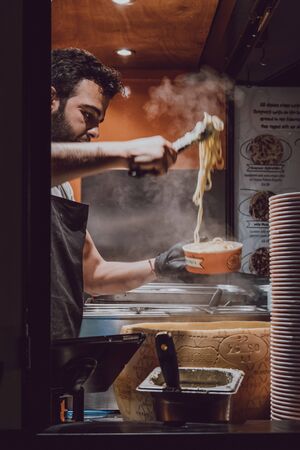Emergence of Hybrid Work and Study Spaces
In the wake of the COVID-19 pandemic, Indian cafés have undergone a remarkable transformation, embracing a new identity that blends work, study, and leisure. No longer just places for catching up over chai or grabbing a quick samosa, these coffee houses have evolved into vibrant hybrid hubs where professionals and students seamlessly merge their daily routines. With the rise of remote work and online learning, cafés from Bengaluru to Mumbai have adapted by offering high-speed Wi-Fi, ample charging points, and quiet corners—catering to the needs of India’s ever-connected youth and workforce.
This shift is deeply influenced by India’s unique cultural fabric. For many Indians, the café is now an “adda”—a community space where ideas brew alongside coffee beans. Here, start-up founders conduct Zoom calls while college students prepare for competitive exams, all within the same aromatic environment. The lines between workplace, classroom, and chill zone have blurred, as café owners curate flexible seating arrangements and digital-first menus to support multitasking patrons. In this new era, the Indian café scene not only supports productivity but also fosters a sense of belonging and creativity among its diverse clientele.
2. Desi Touch: Local Flavours and Comforts
The vibrant Indian café scene has undergone a remarkable transformation post-COVID, with an increased emphasis on homegrown flavours, comforting regional snacks, and an ambience that feels closer to home. In cities like Bengaluru, Mumbai, and Delhi, café menus now proudly flaunt an array of desi delights alongside global staples. The rise in local ingredients and innovative chai offerings is not just a trend—it’s a heartfelt response to the evolving preferences of India’s young professionals and students who seek familiarity and nostalgia as they work or study away from home.
Regional Tastes Take Centre Stage
Traditional items such as filter coffee, masala chai, and snacks like samosas, misal pav, or poha cutlets now share equal billing with lattes and croissants. Cafés are also experimenting with fusion dishes—think tandoori paneer sandwiches or chai-infused cakes. These additions offer patrons comfort and a sense of belonging, especially for those navigating the new normal of remote work or hybrid study routines.
Chai Innovations & Local Brews
The classic chai experience has evolved beyond the humble roadside stall. Urban cafés serve up everything from kadak adrak chai (strong ginger tea) to hibiscus-infused herbal blends. Coffee menus also highlight South Indian filter coffee and single-origin beans from Coorg or Chikmagalur, blending tradition with specialty café culture.
Café Offerings: A Glimpse into the Menu Evolution
| Beverage/Snack | Pre-COVID Café Menus | Post-COVID Café Menus |
|---|---|---|
| Tea Selection | Basic black/green tea | Kashmiri Kahwa, Tulsi Masala Chai, Cutting Chai Variants |
| Coffee Choices | Cappuccino, Latte, Americano | Filter Kaapi, Spiced Cold Brew, Monsoon Malabar Espresso |
| Savoury Snacks | Croissant, Sandwiches | Pav Bhaji Toast, Samosa Pockets, Vada Pav Sliders |
| Desserts/Sweets | Muffins, Brownies | Kulfi Cheesecake, Gajar Halwa Tart, Chai Cake Slice |
The Comfort Factor: Why It Matters?
This shift towards desi flavours is more than culinary creativity; it’s about creating a welcoming space that resonates with local sensibilities. For many Indians adjusting to flexible work-from-café lifestyles or prepping for exams in group study sessions, these familiar tastes and scents evoke a sense of community—making the café not just a place for productivity but for genuine comfort and cultural connection.
![]()
3. Digital Connectivity and Jugaad
In the post-COVID era, Indian cafés have become more than just places to grab a chai or coffee—they’re digital hubs that reflect the country’s ever-evolving work and study culture. The demand for high-speed Wi-Fi and abundant charging points has skyrocketed as students, freelancers, and young professionals flock to these spaces with their laptops and smartphones in tow. Reliable internet is no longer a luxury; it’s a basic necessity. Many cafés now proudly display “Free Wi-Fi” boards at their entrances, and some even offer tiered internet speeds depending on purchase amount—a true sign of the Indian spirit of jugaad, or resourceful improvisation.
This jugaad mentality goes beyond just connectivity. Whether it’s stringing extension cords across tables to ensure every guest can charge their devices, repurposing old furniture into private work pods, or setting up makeshift soundproof corners for video calls, café owners in India are experts at making the most out of limited resources. Customers often share plug points or help each other troubleshoot tech glitches—a sense of community that is uniquely desi. The ability to adapt quickly and creatively is what keeps Indian cafés ahead in catering to the demands of the new normal.
4. Community Building and Informal Networks
In the vibrant post-COVID landscape, Indian cafés have evolved beyond their traditional roles as simple hangout spots. Today, they have transformed into dynamic informal networking hubs where entrepreneurs, freelancers, and students converge, weaving together a unique tapestry of collaboration and innovation. This shift is deeply rooted in Indias evolving work culture, where the boundaries between professional and personal spaces are becoming increasingly fluid.
The Rise of Café-Based Networking
Cafés now serve as micro-ecosystems for budding start-ups and creative minds. The relaxed ambience, reliable Wi-Fi, and availability of affordable snacks like chai, filter coffee, and samosas foster an environment conducive to spontaneous discussions and idea exchanges. Unlike formal offices, these spaces allow individuals from diverse backgrounds to connect organically, often leading to the formation of collaborative teams or mentorship relationships.
Key Drivers of Community Building in Cafés
| Driver | Description |
|---|---|
| Accessibility | Cafés are easily accessible across Tier 1 & Tier 2 cities, making them ideal meeting spots for people from different walks of life. |
| Cultural Relevance | Sharing a cup of chai or coffee is deeply embedded in Indian social fabric, naturally encouraging conversations. |
| Flexibility | No strict time slots or booking requirements—people can drop in as per convenience for both planned and impromptu meetings. |
| Affordability | Most cafés offer pocket-friendly menus catering to students and young professionals. |
Typical Café Communities in India
- Start-up founders brainstorming over masala chai at Bengaluru’s Church Street cafés
- Freelance designers collaborating at co-working friendly outlets in Mumbai’s Bandra area
- Students forming study groups over filter coffee in Chennai’s Anna Nagar cafés
This organic network-building is further enhanced by café-hosted events such as open-mic nights, book readings, or coding meetups—each serving as catalysts for new connections. The sense of belonging nurtured through regular interactions creates a support system that goes beyond professional interests, echoing the Indian ethos of sangha, or community spirit. As more Indians embrace flexible work and study models, the café will continue to be a cornerstone for both community building and informal networking across the country.
5. Wellness, Safety, and Social Distancing
Hygiene Takes Centre Stage
Across India, the post-COVID café landscape is defined by a renewed focus on wellness and hygiene. Cafés from Bengaluru’s start-up corners to Mumbai’s student hotspots have made sanitisation an essential part of their daily operations. Hand sanitisers at entrances, frequent surface cleaning, and clear signage reminding patrons about mask usage have become as common as a cup of chai. These practices not only reassure customers but also demonstrate the café’s commitment to community health, which resonates deeply with Indian values of collective well-being.
Social Distancing: The New Normal
The traditional hustle-bustle of Indian cafés has given way to thoughtfully spaced seating arrangements. Tables are now separated by safe distances, and many cafés use floor markers or creative partitions—sometimes even using plants or bookshelves—to maintain personal space. This change supports both individual study sessions and group work, reflecting the adaptability of Indian youth who balance safety with social connection.
Contactless Service: Technology Meets Tradition
Embracing digital transformation, cafés now offer QR code menus, UPI payments, and app-based ordering—a nod to India’s growing digital literacy. From ordering masala chai via a smartphone to receiving reminders for contactless pickup, these innovations reduce physical touchpoints without sacrificing the warmth of Indian hospitality. For regulars and newcomers alike, this seamless blend of technology and tradition builds trust and ensures a safe yet inviting environment.
Building Customer Trust and Loyalty
With heightened attention to cleanliness and safety protocols, customers feel more comfortable returning to their favourite hangouts. Word-of-mouth travels fast in India; a café that visibly prioritises wellness quickly earns loyal patrons who appreciate this care. In fact, many students and remote workers now select their go-to cafés based on these very standards, making wellness initiatives not just a necessity but a key differentiator in the competitive Indian café scene.
The Boom of Indie and Neighborhood Cafés
In the wake of the pandemic, India’s café landscape has witnessed a remarkable shift with the blossoming of independently owned, hyperlocal cafés. These spaces, often tucked away in residential colonies or bustling local markets, have become more than just coffee stops—they now function as vibrant community hubs and engines for local culture.
Redefining Community Spaces
Unlike large coffee chains that focus on uniformity and mass appeal, indie cafés are weaving themselves into the fabric of their neighbourhoods. Whether it’s a quirky adda in Kolkata, a chai-focused nook in Delhi’s Shahpur Jat, or a peaceful study spot in Bengaluru’s Koramangala, these cafés are tailored to reflect the tastes and aspirations of their immediate surroundings. Their interiors often showcase local art, hand-thrown pottery, or upcycled décor, giving patrons a sense of belonging and ownership.
Supporting Local Artisans and Start-ups
The post-COVID emphasis on supporting local businesses has dovetailed perfectly with the rise of artisanal ventures within café spaces. Many indie cafés collaborate with home bakers, craft chocolatiers, and micro-roasters—sometimes even offering shelf space for handmade goods or hosting weekend pop-ups for small-scale entrepreneurs. This ecosystem fosters entrepreneurship while offering customers truly unique flavours—from filter kaapi roasted down the street to millet cookies baked using grandma’s recipe.
A New Canvas for Expression and Connection
For students and professionals alike, neighborhood cafés have morphed into inspiring havens for remote work and collaborative study. With free Wi-Fi, power outlets at every table, and the gentle hum of activity as background music, these spaces encourage productivity while nurturing serendipitous interactions. Open-mic poetry nights, board game afternoons, or impromptu discussions on current affairs further cement their place as catalysts for social connection and cultural exchange.
The Path Forward: Hyperlocal Resilience
This boom in indie cafés signals an important cultural shift: Indians are increasingly valuing authenticity, community support, and slow living over cookie-cutter convenience. As these neighbourhood cafés continue to thrive post-pandemic, they not only boost local economies but also remind us that sometimes the best brews—and ideas—are found right around the corner.

